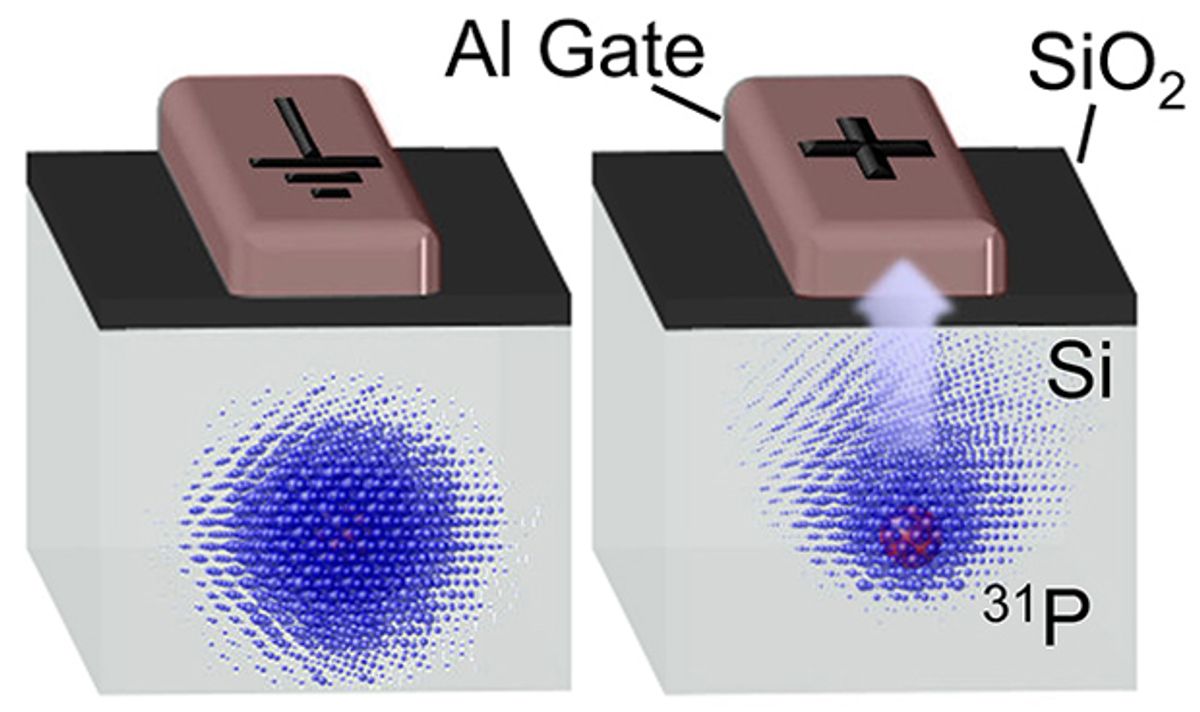Borrowing a page from transistor design, a team led by Andrea Morello at the University of New South Wales in Australia has created an electronic gate that can be used to control especially long-lived quantum bits in silicon. This could help pave the way for full-scale, silicon-based quantum computers.
Quantum computing using superconducting circuits has garnered a lot of press over the years thanks to exciting results, Google’s deep pockets and the controversy over D-Wave’s computing systems. But a number of researchers are eying silicon instead, in part because the material could potentially be used to build computers with especially compact and stable quantum bits, or qubits.
One way to build silicon qubits is to add impurities, or “donors”, such as phosphorus atoms to silicon. Embedded in relative isolation, such qubits have been breaking longevity records; in some incarnations, they can store information for minutes or even hours before losing their delicate quantum state.
But until now, says team member Arne Laucht, researchers could only control—and thus set the state of and perform logic operations on—donor qubits by hitting them with short pulses of a magnetic field that happens to be oscillating at the right frequency.
“This scheme works very well for a single qubit, where one qubit is located next to an on-chip microwave antenna, and one microwave source is used to generate the high frequency pulses,” Laucht told IEEE Spectrum in an e-mail. “But imagine scaling up to 100 or more qubits.” Magnetic fields, he says, are difficult to keep confined to a small space, so they’re liable to affect other qubits in the vicinity. What’s more, Laucht says, each qubit would need its own microwave source, and “each of these sources costs more than $100,000 apiece.”
Fortunately there is another way. In 1998, physicist Bruce Kane laid out a recipe for a silicon-based quantum computer in which each donor gets its own gate. In Kane’s scheme, a single source would wash an oscillating magnetic field over all the qubits in the computer. This field would ordinarily leave the qubits unaffected. But by applying a voltage, one of the donor atom’s electrons could be drawn slightly toward the gate. This would shift the frequencies of oscillating magnetic field to which both the atom’s electron and the atom’s nucleus would respond.
Designed correctly, this arrangement could push an atom’s nucleus into resonance so that its state could be changed. (I say state, but I mean more specifically spin, a property of fundamental particles that can be made to point in either one of two directions, or, like Schrodinger’s cat, a superposition of both).
In this new work, Laucht and colleagues show it’s possible to use this basic approach to control the spins of both an electron and the nucleus of a donor phosphorus atom. The results appeared on Friday in the open-access journal Science Advances.
Laucht says the key to implementing Kane’s gate idea was having silicon that had been isotopically purified to further isolate the donor atoms from magnetic interference from stray spins. This narrowed the linewidth of resonance of the electron, allowing the researchers to move the qubit in and out of resonance with a voltage small enough to avoid disturbing the environment around the qubit.
“There’s no other technique we know of to control individual [qubits] that are very close together,” says John Morton of the University College London. (Morton has worked with the University of New South Wales researchers on previous demonstrations, and he co-authored a survey of silicon quantum computing for IEEE Spectrum last year).
But Morton adds there are a lot of open questions left to be sorted out as researchers contemplate making systems with many such qubits. “What we really need to do is figure out how we’re going to make arrays of dopants in silicon that are able to communicate,” Morton says. “No one has a perfect blueprint yet.”
Kane’s proposal also included gates that would be able to control interactions between qubits. But such gates would be difficult to make since they would have to be made “very, very narrow and positioned exactly between the two atoms”, Laucht says. Fortunately, he says, there are other promising ways to get qubits to interact, and he and his colleagues are on the case.
Rachel Courtland, an unabashed astronomy aficionado, is a former senior associate editor at Spectrum. She now works in the editorial department at Nature. At Spectrum, she wrote about a variety of engineering efforts, including the quest for energy-producing fusion at the National Ignition Facility and the hunt for dark matter using an ultraquiet radio receiver. In 2014, she received a Neal Award for her feature on shrinking transistors and how the semiconductor industry talks about the challenge.




